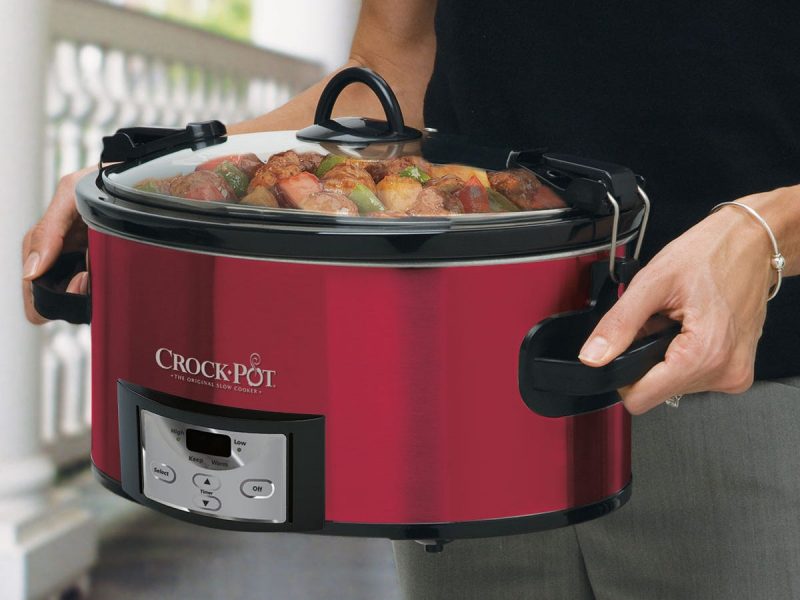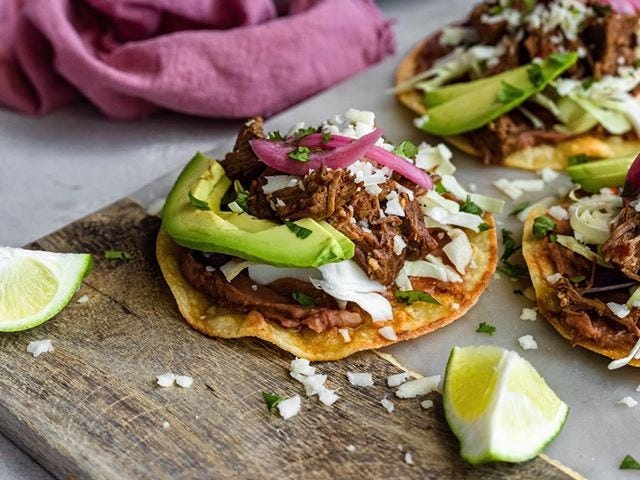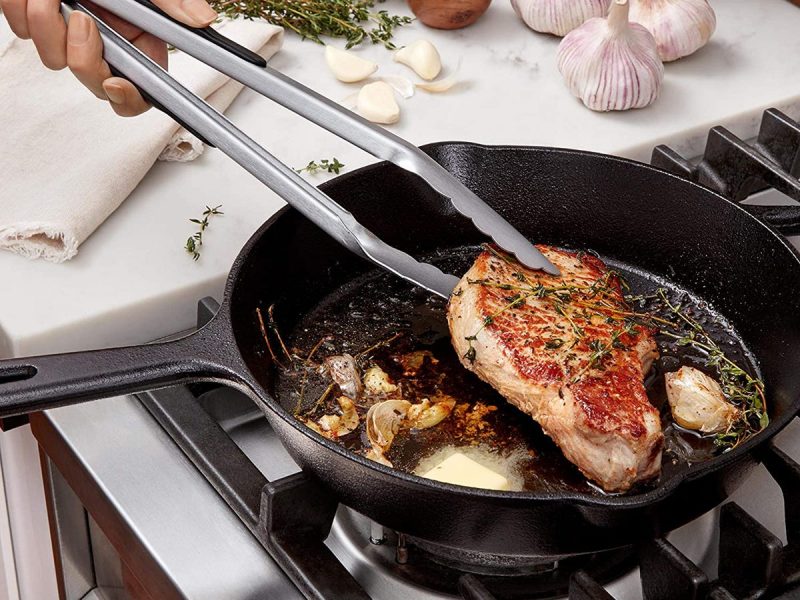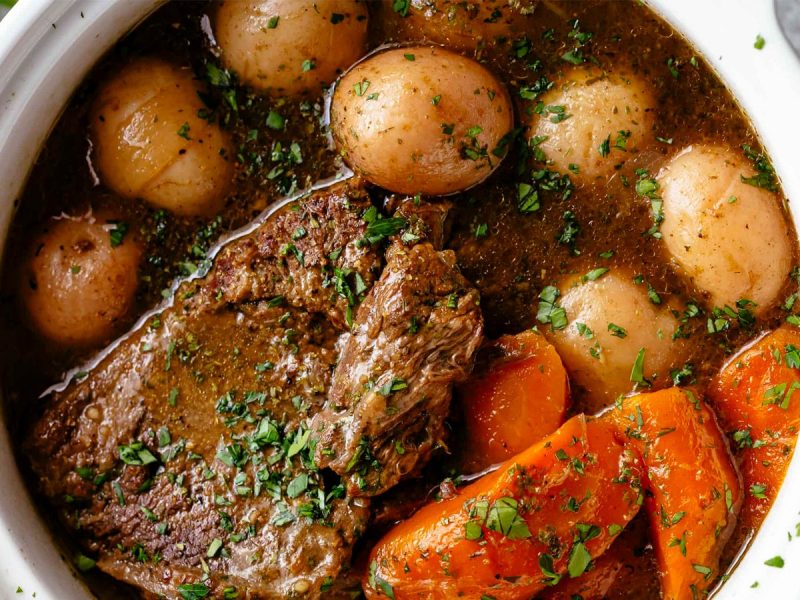- With a slow cooker, you combine low heat and plenty of time to make great-tasting one-pot meals with minimal effort.
- If you don’t have a slow cooker yet, we recommend picking one from Crock-Pot, the company that first popularized the appliance and is synonymous with slow cookers.
- Here’s how slow cookers work and how you can use them at home.
- Read more: The best slow cooker
After working all day, most of us just want to flip on the TV and zone out. The idea of preparing a healthy, delicious meal may not sound appealing so we often end up reaching for frozen foods or takeout.
But with a slow cooker, you can avoid impulse decisions and prepare meals before the day takes your energy away. Slow cookers are a great tool for preparing one-pot meals before you get down to work for the day. When you’re ready to call it quits, your meal will be ready to eat.
What is a slow cooker?
 Foto: Source: Crock-Pot
Foto: Source: Crock-Pot
Much like you might refer to hook-and-loop fasteners as Velcro, facial tissue as Kleenex, and pressure cookers as Instant Pots, most of us use “slow cooker” and “Crock-Pots” interchangeably.
Since Crock-Pot's inception in 1971, its slow cookers have had the same basic parts of a base, an inner pot, and a lid. The base plugs into an outlet and heats the inner pot, which is usually made of stoneware. The pot and its contents are heated to a consistent temperature, typically between 200 and 300 degrees Fahrenheit, and you set it to cook your dishes for at least four hours.
Though you can get excellent slow cookers for under $50, including ones from Crock-Pot, you can also find them for less at secondhand stores if you're on a budget. Though if you go this route, be careful about the wiring and try to test it in-store to make sure it heats up properly before you make your purchase.
If you own a Dutch oven or other large oven-safe pot with a lid, you can turn your oven into a slow cooker. To convert any slow cooker recipe, just set your oven to 200 degrees Fahrenheit for low heat or 300 degrees for high.
How does a slow cooker work?
The slow cooker gets its name from the time it needs to cook meals at low temperatures. This is different from a pressure cooker, like an Instant Pot, which uses intense pressure and a short amount of time. If you're interested in learning to use an Instant Pot, we've got a breakdown here.
Though times vary, most slow cooker recipes call for cooking on low for eight hours. However, you won't be actively working on the meal during that time. The amount of time you spend preparing your meal for the cook is much shorter.
How to use a slow cooker
Here are the most basic steps to use a slow cooker:
- Prep your ingredients.
- Add your ingredients to the pot.
- Put the lid in place.
- Select your preferred heating level.
- Set a timer (if necessary) and go about your day.
- Once the time is up, carefully open the lid and enjoy your meal.
Recipes and ingredient preparation can be as involved as you want. For recipe inspiration, there are countless slow cooker cookbooks. The "Fix-It and Forget-It Big Cookbook" is a popular choice. I've also listed out my favorite dishes and recipes below.
Since slow cookers rely on heat and moisture, they are mainly used for foods you might otherwise boil or simmer, including stocks, pot roasts, soups, beans, dips, and more. You don't want to slow cook crispy or fried foods and you should need to be careful with noodles as they can become mushy fast.
For added flavor, caramelize onions and sauté garlic before you add them to your pot. You can skip these steps if you're in a hurry to get your meal cooking, though I strongly recommend browning your meats before throwing them in the slow cooker. This adds a flavorful crust that can help seal in juices for tastier, juicier meats. The perfect tools for doing this are a good cast iron skillet and tongs. Check out our guide to the best cast iron skillets and pans. For tongs, OXO Good Grips is a smart solution.
Once the ingredients are in the pot and the lid is in place, it's time to choose a temperature setting and start cooking. Most slow cookers have just two settings: Low and High. Low heat is almost always preferable - after all, it's what gives "slow cooking" its name - because longer simmers can extract all of the flavors. Count on meals cooked on the Low setting to take roughly four hours longer than those on High. For instance, dishes that take four hours on High will take about eight hours on Low.
Once the Crock-Pot is cooking, let it be. It's designed to just work on its own, and as mentioned above, removing the lid frequently can mess with your cooking times so only do this if a recipe calls for it. Otherwise, set a timer (if your model doesn't have one built-in), and go about your day.
You might come back after an hour to make sure that the unit is hot. There are countless stories of people who have turned on their non-digital slow cooker only to find out hours later that they'd never plugged it in.
Once the time is up, check to make sure the food is thoroughly cooked. This is unlikely going to be a problem but it doesn't hurt to be safe. You can use a thermometer in the thickest part of the meat and refer to the USDA's recommended internal temperatures guide. Or just cut the biggest piece of meat in half and eyeball it. If it appears to be cooked all the way through, you're good to go. You can serve the meal in the pot itself or on a serving platter if anything needs to be sliced or cut.
How much liquid do I need in a slow cooker?
This depends on the recipe but when adding ingredients, remember that heat makes items expand. Therefore, if you fill the stoneware all the way up to the top, you're likely to have some of the liquids spill over during the cooking process. Go with the recipe and don't fill the pot more than two-thirds or three-quarters of the way full. With this in mind, if you plan on making big pots of food, consider buying a larger Crock-Pot.
You should keep the lid on slow cooker at all times unless you absolutely need to remove it. This protects against temperature fluctuations since a lot of heat is released when the lid comes off. With the lid in place, moisture also stays contained so you need less liquid in the pot than if you were simmering on the stove or in the oven.
What do you need to use a slow cooker?
One of the main benefits of slow cookers is that you don't need extra accessories to make a delicious meal - just the slow cooker itself.
The Crock-Pot 6-Quart Cook & Carry Programmable Slow Cooker is our top pick, but I've tested and liked others from the Crock-Pot family.
One, in particular, is the Crock-Pot Express, which is Crock-Pot's answer to the Instant Pot. Most electric pressure cookers have a slow cooker function, so it's always nice to have one appliance that serves several functions. In my experience though, electric multicookers tend not to slow cook as well as the units devoted to that function.
Where do you put a slow cooker?
One great thing about slow cookers is that you're using low temperatures (usually under 300 degrees Fahrenheit) so there's a decreased chance of danger or fire. However, you still need to be careful about where you place your slow cooker.
Don't place your Crock-Pot on the stove. It's too easy to accidentally turn on a burner and end up with a ruined appliance, a mess, or worse. You should also avoid putting your slow cooker where it might fall into water or people might trip over it.
Don't use an extension cord with your slow cooker if you can avoid it too. If you do need one, make sure it's rated for at least 12 amps and 120 volts, and place it somewhere that people won't trip over the cord. You don't want someone to accidentally send a scalding mess flying through the air.
How do you clean a slow cooker?
During long cooking sessions, food can get caked onto the inner pot, which makes cleanup a real pain. The pots are often heavy and unwieldy to wash by hand and may not fit in your dishwasher, so if you're concerned about this, consider picking up some liners for easier cleanup. We recommend Reynolds Regular Size Slow Cooker Liners.
Slow cooker tips
- Your slow cooker can do more than just make a one-pot meal. It can be used to keep items warm at potlucks, parties, and other events. A friend of mine uses his Crock-Pot to make large batches of hot chocolate during holiday parties. You scoop it into your mug and add your holiday cheer of choice from the bar.
- Since some ingredients may cook at different speeds, you might want to stagger the ingredients you add. For instance, I like to wait until the final three hours of a low-temp cook to add potatoes and carrots to a roast. Dairy products are best added at the end.
- In many cases, the juices left in the pot are like liquid gold. Consider serving them as a sauce or gravy. Use a slurry to thicken it up. A slurry consists of 1 part cornstarch to 2 parts cold water. Start with small amounts (think a tablespoon or two) and slowly whisk more in until it thickens.
- Many slow cooker and Instant Pot recipes are interchangeable. If a meal takes an hour in the Instant Pot on high pressure, count on it taking 8 hours in the slow cooker on Low.
- If the idea of getting up early to prep your ingredients before heading to work sounds unappealing, you can prep items the night before and store them in the pot in the refrigerator. That way, in the morning, you can just take it out, put it in the base, and start cooking.
Easy slow cooker recipes
Now that you have a good idea of how a slow cooker works, here are a few of my favorite meals:
Chili, soups, and stews: Soups and stews are great in Crock-Pots, but this device was made for the chili lover. It keeps your creation at a low simmer, and when it's ready, you can use the "Keep Warm" mode so the chili is ready for second and third helpings throughout the evening. Here's an excellent Betty Crocker recipe using beer that really puts it over the top.
Roasts: Though I prefer sous vide for cheap cuts of meat, slow cookers also do an outstanding job of breaking down 3-pound pieces of beef into tender, flavorful meals. I made this recipe recently with items I picked up from my CSA, and it was a hit.
Pulled pork: If you don't have a smoker, you can get a similar pulled pork experience with a slow cooker. Here's an easy recipe. I recommend adding some liquid smoke to give it more flavor complexity.
Chicken breast with salsa and cheese: When I'm lazy or in a rush, I sometimes just toss a pound or two of chicken breasts into the slow cooker, cover it with a container of salsa, and let it cook on low for about 8 hours. When there's about an hour left, I add a bunch of cheese. When it's done, I shred the chicken and serve the concoction over rice. It also works well in a tortilla with additional toppings.
BBQ chicken with baked potato casserole and cheesy corn: This is primo Midwest cuisine I picked up while testing Chefman's triple slow cooker. For this, you'll need a triple slow cooker so all the components are ready at the same time. The Chefman model is no longer available but I also recommend trying HomeCraft.


